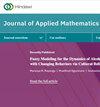Ecoepidemiological Model and Optimal Control Analysis of Tomato Yellow Leaf Curl Virus Disease in Tomato Plant
IF 1.3
Q2 MATHEMATICS, APPLIED
引用次数: 0
Abstract
The purpose of this study is to analyze the impact of control strategies, namely, insecticide spray, roguing of a diseased tomato plant, and protective netting to protect tomato plant from tomato yellow leaf curl virus disease (TYLCVD). For this, we formulate and analyze a simple deterministic model for the transmission dynamics of TYLCVD that incorporates these control strategies. We initially take into account the constant control case, we calculate the basic reproduction number, and we investigate the existence and stability of the disease-free and endemic equilibria. We use the Kamgang-Sallet stability to ensure that the disease-free equilibrium point is globally asymptotically stable when the reproduction number is less than one. This indicates that TYLCVD dies out independent of the initial size of the tomato population. For , the disease-free equilibrium becomes unstable, and the endemic equilibrium is globally asymptotically stable. This indicates that TYLCVD propagates. In the nonconstant control case, we use Pontryagin’s maximum principle to derive the necessary conditions for the optimal control of the disease. Our findings show that all the combined efforts of two out of three strategies can significantly reduce the power of infectivity of the disease except the combination of the use of insecticide spray and rouging infected tomato plants. Besides our numerical simulations show, the implementation of the combination of roguing diseased plants and protective netting has a similar effect in minimizing or eliminating TYLCV as the use of all strategies. Hence, as resources are always in scarce, we recommend policymakers to adapt the combination of the use of roguing diseased tomato plants and protective netting to eradicate the disease.番茄黄曲叶病毒病生态流行病学模型及最优控制分析
本研究的目的是分析杀虫剂喷洒、病株清除和防护网对番茄黄曲叶病毒病(TYLCVD)的防治效果。为此,我们制定并分析了一个包含这些控制策略的TYLCVD传输动力学的简单确定性模型。我们首先考虑了恒定控制情况,计算了基本繁殖数,并研究了无病平衡点和地方性平衡点的存在性和稳定性。我们利用Kamgang-Sallet稳定性来保证当繁殖数r0小于1时无病平衡点是全局渐近稳定的。这表明TYLCVD的消亡与番茄群体的初始大小无关。对于r0 <1、无病平衡不稳定,地方性平衡全局渐近稳定。这表明TYLCVD在传播。在非恒定控制情况下,利用庞特里亚金极大值原理推导出疾病最优控制的必要条件。我们的研究结果表明,三种策略中的两种策略的联合努力都可以显着降低疾病的传染性,除了使用杀虫剂喷雾和感染番茄植株的组合。此外,我们的数值模拟表明,在最小化或消除TYLCV方面,实施患病植物和防护网的组合与使用所有策略具有相似的效果。因此,在资源总是稀缺的情况下,我们建议政策制定者结合使用清除患病番茄植株和防护网的方法来根除这种疾病。
本文章由计算机程序翻译,如有差异,请以英文原文为准。
求助全文
约1分钟内获得全文
求助全文
来源期刊

Journal of Applied Mathematics
MATHEMATICS, APPLIED-
CiteScore
2.70
自引率
0.00%
发文量
58
审稿时长
3.2 months
期刊介绍:
Journal of Applied Mathematics is a refereed journal devoted to the publication of original research papers and review articles in all areas of applied, computational, and industrial mathematics.
 求助内容:
求助内容: 应助结果提醒方式:
应助结果提醒方式:


